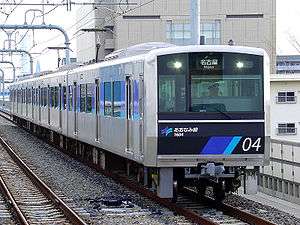Aonami Line
| Aonami Line | |
|---|---|
|
A 1000 series EMU | |
| Overview | |
| Type | Commuter rail |
| Locale | Nagoya |
| Termini |
Nagoya Kinjō-Futō |
| Stations | 11 |
| Operation | |
| Opened | 2004 |
| Owner | Nagoya Seaside Rapid Railway |
| Rolling stock | 1000 series |
| Technical | |
| Line length | 15.2 km (9.4 mi) |
| Track gauge | 1,067 mm (3 ft 6 in) |
| Minimum radius | 191 m |
| Electrification | 1,500 V DC, overhead catenary |
| Operating speed | 110 km/h (70 mph)[1] |
The Aonami Line (あおなみ線 Aonami-sen) is a third-sector railway line in the city of Nagoya operated by the Nagoya Seaside Rapid Railway (名古屋臨海高速鉄道 Nagoya Rinkai Kōsoku Tetsudō). Officially called the Nishi-Nagoyakō Line (西名古屋港線 Nishi-Nagoyakō-sen, West Nagoya Port Line), it connects Nagoya Station with Kinjō-Futō Station, and was a freight branch line of Tokaido Main Line, converted for passenger usage in October 2004.[1]
This line is still operated as a freight line by Japan Freight Railway Company (JR Freight) between Nagoya and Nagoya Freight Terminal, and so the section between Nagoya and Arako Station is used for both passenger and freight traffic.
Stations
| Number | Station name | Japanese | Distance (km) |
|---|---|---|---|
| AN01 | Nagoya | 名古屋 | 0.0 |
| AN02 | Sasashima-raibu | ささしまライブ | 0.8 |
| AN03 | Komoto | 小本 | 3.3 |
| AN04 | Arako | 荒子 | 4.3 |
| AN05 | Minami-Arako | 南荒子 | 5.2 |
| AN06 | Nakajima | 中島 | 5.9 |
| AN07 | Nagoya Keibajō-mae (Nagoya Race Course) | 名古屋競馬場前 | 7.1 |
| AN08 | Arakogawakōen | 荒子川公園 | 8.2 |
| AN09 | Inaei | 稲永 | 9.8 |
| AN10 | Noseki | 野跡 | 12.1 |
| AN11 | Kinjō-Futō | 金城ふ頭 | 15.2 |
Rolling stock
Services on the line are operated by a fleet of eight four-car 1000 series electric multiple unit (EMU) trains.[2]
History
The Nishi-Nagoyakō Line opened on 1 June 1950 as a freight branch of the Tokaido Main Line between Sasashima Freight Terminal (笹島貨物) and Nishi-Nagoyakō (西名古屋港) operated by Japanese National Railways (JNR).[1] Nagoya Freight Terminal opened on 1 October 1980, and with the closure of Sasashima Freight Terminal on 1 November 1986, Nagoya Freight Terminal became the starting point of the line.[1] With the privatization and division of JNR on 1 April 1987, the line was transferred to Central Japan Railway Company (JR Central) as a "Class 1 railway operator" and JR Freight as a "Class 2 railway operator".[1]
Plans to operate passenger services on the line were formalized in the 1990s, and Nagoya Seaside Rapid Railway company was established in 1997 as a third-sector company funded by the city of Nagoya.[1] The passenger Aonami Line utilized approximately 12 km of existing freight line with a new approximately 4 km extension to Kinjō-Futō Station.[1] This opened on 6 October 2004, and at the same time, the section of track between Nagoya Station and Nagoya Freight Terminal was closed.[1]
Despite serving attractions such as the Nagoya International Exhibition Hall and Nagoya Race Course, passenger ridership figures fell short of targets, and in July 2010, the operating company declared debts of approximately 46 billion yen, applying for alternative dispute resolution (ADR) to avoid bankruptcy.[1]
References
External links
| Wikimedia Commons has media related to Aonami Line. |
- Official website (Japanese)
